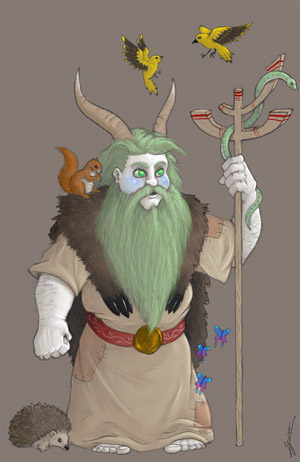Lesnik was the forest spirit of the Old Slavs. His connection to the woods is visible in his very name, since "les" in the Old Slavic language (and in many living Slavic languages as well) means "forest". In the areas surrounding Vranje this forest spirit was called "Suman". In Russia he was called "Ljesi", and we are also familiar with the names "Ljesovik", "Lesak", "Lesnoj" and "Lisun". His wife's name was "Lesacaha", "Lesoviha" or "Lesiha".
 |
Lesnik was imagined as an anthropomorphic creature, but he had the head of a horned animal and was dressed in fur. It was not uncommon to imagine him with hooves. In rituals, men would appear masked as Lesnik and tease "snaska". Snaska was a man dressed as a woman. In these rituals, the man wearing the mask was identified with the mask, i.e. the creature whose mask he was wearing.
Lesnik was favourably disposed towards the shepherds and watched over their flocks. He was also the protector of wild animals, a feature that seems contradictory to the previous one, since wild and domestic animals were perceived as traditional enemies. But this role of his was, in the mind of the man of that time, completely acceptable, because Lesnik was in charge of managing relations between them. It was believed that someone had to solve the problems of antagonism. This role was later transferred onto St. Sava, who was the protector of domestic animals and at the same time the shepherd of the wolf pack. Lesnik could appear in completely human form, only that he would then have just one eye or have no eyelashes. According to folk stories, Lesniks lived in every larger forest. They frequently kidnapped beautiful women and took them to their cottages, which were covered with fur. They also made the girls dance in circle around them. Some people believed that Lesnik was all covered in fur. Bears were his pets and they were often together. Lesnik was sometimes imagined as a shepherd whose flock consisted of bucks, does and rabbits, guarded by wolves and lynx. Legend says that Lesnik had no shadow. He announced his arrival by making tremendous noise. He also played the reed-pipe superbly.
.jpg) |
No comments:
Post a Comment